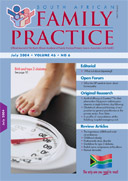A profile of resuscitations at the Kalafong hospital emergency unit.
Abstract
Background: All serious emergency cases arriving at the Kalafong Hospital emergency department are first resuscitated by doctors from the Family Medicine Department. The aim of this study was to construct a profile of the patients that the emergency unit doctors consider necessary to admit to the resuscitation unit and to describe the procedures carried out on them. Method: All data from the records of resuscitated patients from 1 July 2000 until 31 December 2000 were included in the study. Results: During the period of the study, 309 patients were resuscitated. Two hundred and three patient records could be traced, of which five files were excluded due to insufficient data. Medical complications were the most common reasons for resuscitation. These patients presented with complications due to chronic diseases such as heart failure, myocardial infarction, diabetic complications, hypertensive crisis and stroke. Suicide attempts were also common, with organophosphates often being used in the attempted suicide. Men between the ages of 18 and 40 under the influence of alcohol were the most frequent type of patients resuscitated for trauma injuries. Gunshot wounds and car accidents were the major causes of serious injuries. Conclusions: The disease profile of the resuscitation patients reflects the medical and social problems of our society. A holistic, bio-psychosocial approach to health care in the primary health care setting could prevent resultant mortality and morbidity. (SA Fam Pract 2004;46(6): 28-31)
Published
2004-07-01
Issue
Section
Original Research
By submitting manuscripts to SAFP, authors of original articles are assigning copyright to the South African Academy of Family Physicians. Copyright of review articles are assigned to the Publisher, Medpharm Publications (Pty) Ltd, unless otherwise specified. Authors may use their own work after publication without written permission, provided they acknowledge the original source. Individuals and academic institutions may freely copy and distribute articles published in SAFP for educational and research purposes without obtaining permission.

